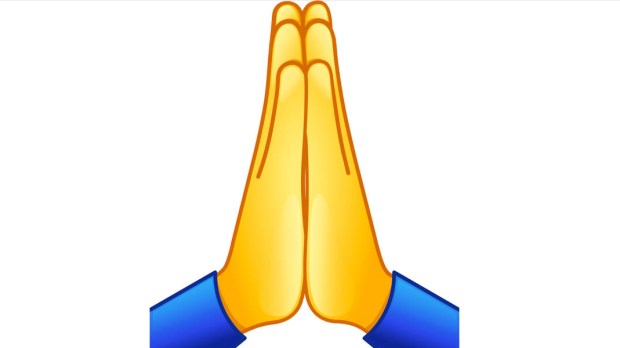The debate is on over the proper interpretation of the “prayer hands” emoji after ABC 6 in Philadelphia suggested that the little picture of two hands pressed flat together — used obsessively by some Christians on social media — was actually a “high-five.”
Fans of the “prayer hands” emoji were quick to defend their usage, citing several reasons why they believe that the emoticon does not work as a high-five:
- Both of the sleeves are the same color, suggesting they come from the same shirt
- “High fives” are traditionally performed with the same side hand of two people, which would cause the thumbs to be on opposite sides. In the “prayer hands” emoji the thumbs are on the same side.
- Some versions of the image show rays of light emanating from the hands, which suggest the light of God. (However, these lines could also act as a representation of the “smack” sound, or to make the high-five seem more epic).
This is not the first time people have been surprised by the ambiguous interpretation of this emoji. In July, a user from the popular chat app WhatsApp was upset when a search for a “high-five” emoji led to the picture she had always interpreted as “prayer hands.”
https://twitter.com/Mahnoorizhere/status/885850632774717440
It is possible that the emoji was meant to serve more than one purpose; even Emojipedia suggests that it can be used for both.
The “prayer hands” gesture has many different meanings around the world. In Christianity it is a sign of piety and reverence while in prayer, but in Japan it is added to a bow to show thanks. All throughout Asia it is known as Añjali Mudrā, a sign of greeting and respect. It is also used in many yoga positions positions, as well as when one might say “Namaste” in the Hindu tradition.
We may never know what the makers of this emoji intended, but it is good to remember that it’s all about your perspective. If you see a “high-five” that can be what it is, and if you use it to say you’re praying that works too. After all, emojis are becoming their own language, with their own translations of novels and even the Bible. If English can bring multiple meanings to words like bear, address, seal, and duck, who’s to say that an emoji can’t mean many things. After all, a picture is worth a thousand words.

